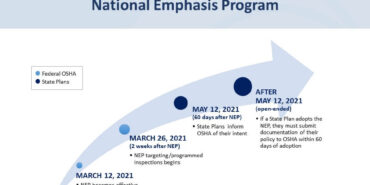Responding to President Biden’s Executive Order of January 2021, OSHA announced, effective for the next 12 months (beginning March 12, 2021), their National Emphasis Program (NEP) for COVID-19. The OSHA NEP, along with new instructions and guidance to Area Offices and Compliance Safety and Health Officers (CSHOs) to handle COVID-19-related complaints, referrals, and severe illness reports can all be found in OSHA’s Interim Enforcement Response Plan (IERP). The IERP focuses enforcement efforts on “high-hazard” industries and worksites where employees may have a high frequency of close contact exposures to SARS-CoV-2.
OSHA states the goal of their new NEP is to significantly reduce and/or eliminate worker exposure to SARS-CoV-2 by targeting industries and worksites in which employees may have a higher frequency of close contact exposures and therefore, the need to control the health hazards associated with such exposure is key. The NEP enforcement program focuses on responding to “unprogrammed” COVID-19 related activities (e.g., complaints, referrals, and severe incident reports) by adding a component to target the specific high-hazard industries or activities where there is an increased potential risk of exposure by a combination of inspection targeting, outreach to employers, and compliance assistance.

Under a normal NEP, OSHA is required to conduct outreach for 90 days before initiating inspections. In the case of the NEP for COVID-19 (COVID-19 NEP), due to the pandemic over the last year, the outreach is considered as already conducted nationally and regionally and therefore the 90-day outreach requirement is satisfied allowing OSHA Area Offices to initiate inspections pursuant to this NEP immediately.
For programmed inspections, the COVID-19 NEP will generate two Master Lists for site selection that include all industry worksites with a North American Industry Classification system (NAICS) code listed in Appendices A and B of the NEP. Master List 1 are establishments identified as having a NAICS code in Appendices A and B or Master List 2 are establishments having a NAICS code listed in Appendices A and B and having an elevated illness rate as indicated by Form 300A data.
Appendix A: Primary Target Industries for the COVID-19 NEP includes healthcare and nursing care facilities, along with other “frequent offender industries” based on enforcement data, including supermarkets, restaurants, meat and poultry processing, and general warehousing and storage.
- Appendix B: Secondary Target Industries for the COVID-19 NEP contains NAICS codes for “Secondary Target Industries” industries with employees who purportedly have the highest frequency of close contact exposures to the public and/or co-workers, including building construction, food and beverage manufacturing, and other manufacturing industries.
OSHA strongly encourages State Plans to adopt the new OSHA COVID-19 NEP, although does not required they do so. In states with an OSHA State Plan (e.g., California) where the state government handles enforcement of safety regulations, the state is required to notify federal OSHA within 60 days of March 12th whether they, the state, intends to adopt the NEP, implement similar initiatives, or rely upon their own standards or policies.
Whistleblower Protection Program
By Presidential Executive Order on Protecting Worker Health and Safety dated January 2021, President Biden directed OSHA to focus its enforcement efforts related to COVID-19 on violations that put the largest number of workers at increased potential risk of exposure and disease, on an employer that engages in retaliation against employees who complain about unsafe and unhealthful conditions or exercise other rights under the Occupational Safety and Health (OSH) Act. As such, the OSHA COVID-19 NEP includes a Whistleblower Protection Program that adds a focus to ensure workers protection from retaliation. Workers requesting inspections, complaining of SARS-CoV-2 exposure, or reporting injuries or illnesses or retaliation, may be covered under one or more whistleblower protection statutes. Worker retaliation protection information and how to file a retaliation complain can be found at https://www.whistleblowers.gov/.
Efforts to protect whistleblowers from retaliation include distribution of anti-retaliation information during inspections and outreach opportunities, as well as promptly referring allegations of retaliation to the Whistleblower Protection Program.
The NEP program falls short of issuing an emergency COVID-19 safety standard, which was speculated as part of President Biden’s January 2021 executive order. It is currently unclear if OSHA or the President consider this NEP a response to the order or if an emergency standard will be established at a later date. OSHA notes the COVID-19 “is effective for no more than 12 months from the effective date, unless canceled or extended by a superseding directive”.
RHP’s Certified Industrial Hygienists, Health Scientists, and Certified Safety Professionals employ their experience and training to advise and guide industry and business leaders in navigating the uncertainties and challenges presented during and after the COVID-19 pandemic. RHP utilizes knowledge and expertise combined with our experience interpreting and incorporating the regulations and guidance of Federal, State, and local agencies and leading Public Health and institutional resources, to facilitate client responses to the rapidly evolving pandemic concerns of COVID-19.
